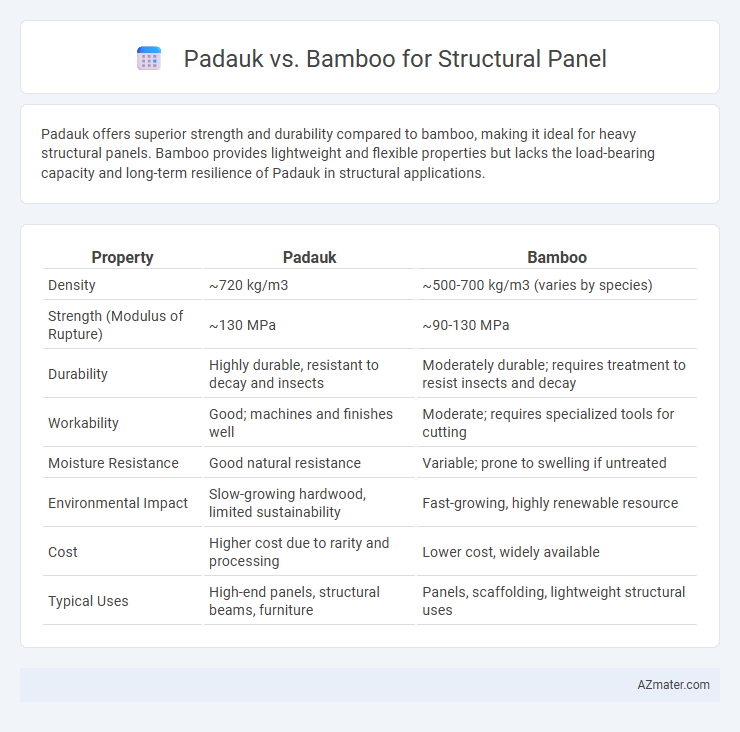Padauk offers superior strength and durability compared to bamboo, making it ideal for heavy structural panels. Bamboo provides lightweight and flexible properties but lacks the load-bearing capacity and long-term resilience of Padauk in structural applications.
Table of Comparison
| Property | Padauk | Bamboo |
|---|---|---|
| Density | ~720 kg/m3 | ~500-700 kg/m3 (varies by species) |
| Strength (Modulus of Rupture) | ~130 MPa | ~90-130 MPa |
| Durability | Highly durable, resistant to decay and insects | Moderately durable; requires treatment to resist insects and decay |
| Workability | Good; machines and finishes well | Moderate; requires specialized tools for cutting |
| Moisture Resistance | Good natural resistance | Variable; prone to swelling if untreated |
| Environmental Impact | Slow-growing hardwood, limited sustainability | Fast-growing, highly renewable resource |
| Cost | Higher cost due to rarity and processing | Lower cost, widely available |
| Typical Uses | High-end panels, structural beams, furniture | Panels, scaffolding, lightweight structural uses |
Introduction to Structural Panels: Padauk vs Bamboo
Structural panels made from Padauk offer exceptional durability and rich reddish-brown color, making them suitable for high-end architectural applications requiring strength and aesthetic appeal. Bamboo panels, derived from fast-growing grass species, provide a lightweight, sustainable alternative with remarkable tensile strength and natural flexibility, ideal for eco-friendly construction projects. Comparing Padauk and bamboo involves evaluating factors such as load-bearing capacity, environmental impact, cost-efficiency, and long-term performance in structural uses.
Material Overview: Padauk and Bamboo Properties
Padauk wood features high density, natural resistance to decay, and excellent dimensional stability, making it ideal for structural panels requiring durability and strength. Bamboo offers rapid growth, superior tensile strength, and lightweight properties, providing a sustainable and flexible alternative for panel construction. Both materials exhibit distinct mechanical properties, with Padauk excelling in hardness and Bamboo favored for its eco-friendly characteristics and efficient load distribution.
Strength and Durability Comparison
Padauk offers superior hardness and density compared to bamboo, making it more resistant to impact and heavy loads in structural panels. Bamboo, while less dense, excels in tensile strength and flexibility, providing excellent resistance to bending and shear forces. Durability-wise, Padauk's natural oils and hardness contribute to better resistance against moisture, rot, and insect damage, whereas bamboo requires thorough treatment to achieve similar longevity in structural applications.
Environmental Sustainability Considerations
Padauk wood offers durability and natural resistance to decay, but its limited availability raises concerns about deforestation and habitat loss, impacting biodiversity. Bamboo, a rapidly renewable resource, grows quickly and sequesters more carbon, making it a superior choice for eco-friendly structural panels. Bamboo's efficient harvesting cycle and regeneration contribute significantly to reducing the environmental footprint compared to traditional hardwoods like Padauk.
Weight and Workability Differences
Padauk wood is denser and heavier than bamboo, making it more suitable for applications requiring high structural strength but adding to overall panel weight. Bamboo offers superior workability due to its lighter weight and uniform fibrous structure, allowing easier cutting, shaping, and faster installation in structural panels. Weight considerations favor bamboo for projects needing lightweight materials, while Padauk provides robustness ideal for heavy-duty structural applications.
Cost Analysis and Market Availability
Padauk panels typically incur higher costs due to the wood's density, durability, and limited supply compared to bamboo, which benefits from rapid growth and widespread cultivation leading to lower prices. Bamboo's abundant market availability and eco-friendly appeal make it a cost-effective choice for large-scale structural panel applications. In contrast, Padauk's premium pricing restricts its use to niche markets that prioritize aesthetic appeal and strength over budget constraints.
Moisture Resistance and Weather Performance
Padauk exhibits superior moisture resistance due to its dense grain structure and natural oils, making it highly suitable for exterior structural panels in humid or wet environments. Bamboo, while sustainable and strong, is more prone to swelling and degradation when exposed to prolonged moisture without proper treatment. Weather performance of Padauk also surpasses Bamboo, maintaining dimensional stability and resistance to rot over extended outdoor exposure.
Aesthetic Appeal and Design Flexibility
Padauk offers a rich reddish-orange hue that deepens over time, providing a striking and exotic aesthetic ideal for high-end structural panels, while bamboo features a lighter, natural tone with distinctive grain patterns that suit modern, minimalist designs. Bamboo's inherent flexibility allows it to be engineered into various panel shapes and sizes, enhancing design versatility, whereas Padauk's dense, hardwood nature supports intricate carvings and detailed finishes for more ornate applications. Both materials excel in offering unique visual appeal but cater to different stylistic preferences and architectural demands in structural panel design.
Common Applications in Construction
Padauk offers superior durability and natural resistance to decay, making it ideal for heavy-duty structural panels in flooring and load-bearing walls. Bamboo provides excellent tensile strength and sustainability benefits, commonly used in eco-friendly construction for wall partitions and ceiling panels. Both materials support high-strength panel applications, with Padauk favored in outdoor and high-moisture environments, while Bamboo suits lightweight, flexible interior structures.
Final Verdict: Choosing Between Padauk and Bamboo
Padauk offers superior durability and natural resistance to insects and decay, making it ideal for long-lasting structural panels in harsh environments. Bamboo provides excellent sustainability, rapid renewability, and impressive tensile strength, which benefits eco-conscious projects requiring flexible yet strong panels. Selecting between Padauk and Bamboo depends on project priorities: choose Padauk for premium durability and aesthetic appeal, or Bamboo for cost-effective sustainability and environmental impact reduction.

Infographic: Padauk vs Bamboo for Structural Panel
 azmater.com
azmater.com